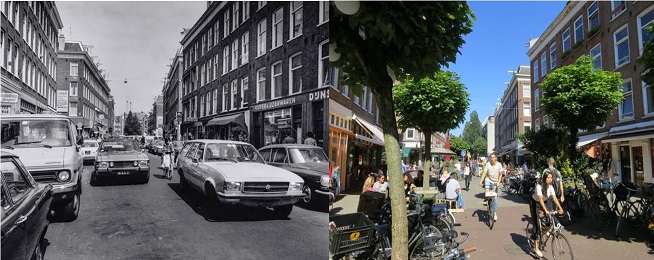The recent Bike Futures seminar heard from Dr Elliot Fishman, fresh from his latest study tour of The Netherlands, on how infrastructure can encourage cycling.
Dr Fishman worked at Utretcht University in The Netherlands and maintains ties with the country, conducting annual study tours through the Institute of Sensible Transport.
The Netherlands has many miles of completely separated cyleways, but it also has other street treatments sympathetic to riding.
The country can show us the way in creating streets that people want to visit, including those streets where cars are seen as “guests”.
In these streets, the road surface is a russet red, the colour of Dutch cycling lanes, with signs letting drivers know that people riding and walking have priority.
Other 30km/h roads have the red cycling lanes on both sides but the narrow centre space for cars is paved to slow drivers down and provide the reminder to look out for riders.
On highways or busy arterial roads where cars are the dominant form of transport, cyclists are still catered for.
The City of Einhoven recently built a floating roundabout for cyclists above a large rural roundabout with heavy vehicle traffic, known as the hovenring. Before the floating ring was built the vehicle roundabout had the traditional Dutch treatment for cycling, but the new infrastructure completely separates cyclists.
Potential riders
Dr Fishman, referred to his research of potential bicycle riders which reiterated the results from the Portland Bureau of Transportation that only a small percentage of the population are comfortable riding on roads with no bicycle lanes.
Like the US research, Dr Fishman discovered that separated lanes and paths were the preferred mode of infrastructure among three different research groups.
Dr Fishman made the point that people don’t make transport choices in isolation, it’s about choosing the right mode of transport for the task.
He talked about the carrying capacity of different transport modes as well as their carbon footprint, with bicycles coming in second behind pedestrians in terms of emissions and space taken up.
Bike share schemes
Bike share schemes are in the news at the moment with the departure of two of the Chinese dockless companies.
Dr Fishman discussed the success of the schemes to date in Melbourne and Brisbane and how they compare with schemes in the US and UK in getting people out of cars.
Each city differed in the mode of transport that had been avoided by a bike share trip. Melbourne and Brisbane had around 20% of avoided car trips compared to Washington and London, which were well under 10%.
His presentation ended with a before and after image of a street in Amsterdam. In the 1970s it was four lanes of cars and not much else, and today it has street trees, outdoor dining and walking and pedestrian priority.
“Hobart is constantly evolving as a city; and its streets need to evolve in order to support Hobart’s ambition for the city it wants to be.”


